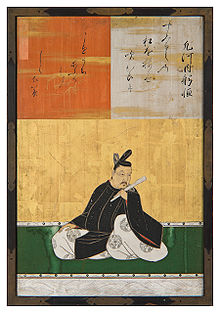art.wikisort.org - Artist
Kanō Tan'yū (狩野 探幽, 4 March 1602 – 4 November 1674) was one of the foremost Japanese painters of the Kanō school. His original given name was Morinobu; he was the eldest son of Kanō Takanobu and grandson of Kanō Eitoku. Many of the most famous and widely known Kanō works today are by Tan'yū.
Kanō Tan'yū | |
|---|---|
 Portrait of the artist, attributed to pupil Momoda Ryūei | |
| Born | 4 March 1602 |
| Died | 4 November 1674 |
| Nationality | Japanese |
| Movement | Kanō school |


In 1617, Tan'yū was appointed by the Tokugawa shogunate to become the shogunate's first official painter.[1] Over the following years, he was given many highly prestigious commissions. Over the 1620s and 1630s, he created a number of large-scale works for Edo Castle, Nijō Castle, Osaka Castle, Nagoya Castle, and Nikkō Tōshō-gū.
Prolific in a variety of painting styles, Tan'yū's most famous works are probably those he produced for these large-scale commissions. They are screens and panels, prime examples of the Momoyama style, depicting natural subjects such as tigers, birds and plants, in bright colors and with extensive use of gold leaf. The gold, often used to represent clouds, water, or other background elements, would reflect what little light was available indoors, brightening a castle's dark rooms.
Tan'yū was also accomplished, however, in monochrome ink painting based on the prototypical style of the Muromachi period, yamato-e compositions in a style similar to that of the Tosa school, and Chinese style scrolls. His most famous yamato-e work is a narrative handscroll depicting the life of Tokugawa Ieyasu, the first Tokugawa shōgun and major figure in Japanese history. It was after this commission, in 1640, that the artist first took on the "artist name" of Tan'yū.
In addition to being a highly honored and respected painter in his own right, Tan'yū was known as a collector and connoisseur of Chinese paintings. He made sketches and kept records of many of the paintings that passed through his studio, brought to him for authentication.
He died in 1674 at the age of 72
See also
- Kusumi Morikage
References
- "Portrait of Kanô Tan'yû". e-museum: National Treasures and Important Cultural Properties of National Museums, Japan. Retrieved 11 February 2017.
- Kaputa, Catherine (1985). "Kanō Tan'yū." Kodansha Encyclopedia of Japan, Tokyo: Kodansha Ltd.
External links
- Brief Biography of Kano Tanyu - Jyuluck-Do Corporation
- Works in the collection of the Metropolitan Museum of Art.
На других языках
[de] Kanō Tan’yū
Kanō Tan’yū (japanisch 狩野 探幽, eigentlich: Kanō Morinobu (狩野 守信); * 4. März 1602 in Kyōto; † 4. November 1674) war ein bedeutender japanischer Maler der frühen Edo-Zeit. Er führte die Kanō-Schule zu neuem Ansehen.- [en] Kanō Tan'yū
[es] Kanō Tannyū
Kanō Tannyū fue un pintor japonés de asuntos de género, animales y composiciones murales de la escuela Kanō. Su verdadero nombre era Kanō Morinobu, apodado Shirojirō, Uneme. Firmó bajo varios nombres artísticos diferentes: Tannyû, Byakurenshi, Hippōdaikoji, Seimei. Nació el 4 de marzo de 1602 y falleció el 4 de noviembre de 1674,[fr] Kanō Tan'yū
Kanō Tan'yū, de son vrai nom Kanō Morinobu, surnommé Shirojirō, Uneme, de noms de pinceau : Tan'yû, Byakurenshi, Hippōdaikoji, Seimei, né le 4 mars 1602 et mort le 4 novembre 1674, est un peintre japonais de sujets de genre, animaux et compositions murales de l'école Kanō. Par sa personnalité, Tan'yū domine l'école Kanō de l'époque d'Edo.[ru] Кано Танъю
Кано Танъю (яп. 狩野 探幽, род. 4 марта 1602 г. — ум. 4 ноября 1674 г.) — японский художник, мастер школы живописи Кано. Его имя при рождении было Кано Моринобу. Кано Танъю — старший сын художника Кано Таканобу и внук Кано Эйтоку. Внучка Кано Танъю — известная художница XVII века Киёхара Юкинобу[2].Другой контент может иметь иную лицензию. Перед использованием материалов сайта WikiSort.org внимательно изучите правила лицензирования конкретных элементов наполнения сайта.
WikiSort.org - проект по пересортировке и дополнению контента Википедии